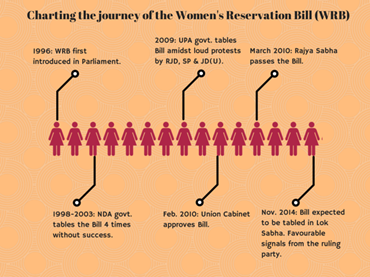Tuesday, 9th March 2021
On International Women's Day, Women MPs seek passage of Women's Reservation Bill
In News
Several women members of Parliament spoke in Rajya Sabha on the occasion of International Women's Day. During the discussion, MPs highlighted the issue of lack of women representation in leadership roles and pushed for 33% reservation for women in Parliament.
Status of political representation to the women in India
· In the 2019 Lok Sabha elections, the percentage of women elected stood at 14.36, the highest since Independence. The number of women in the Rajya Sabha is 27, constituting 10.4%.
· The participation of women in State Assemblies is still lesser. Only 9% constitute members of the Legislative Assembly while only 5% are members of the Legislative Councils.
· The 73rd and 74th Constitutional Amendment had introduced provisions, which provide that
o One-third of the total number of seats should be reserved for women.
o One-third of the seats reserved for the SCs and STs should also be reserved for women.
o One-third of the offices of chairpersons at all levels should be reserved for women.
o The reservations are rotational in nature i.e., for a certain period, certain panchayats or municipalities should be reserved for women on a rotational basis.
· Currently, 14 states have 50-58% representation of women in Panchayats. Jharkhand is the highest with 58%, closely followed by Rajasthan and Uttarakhand.
· As per the Inter Parliamentary Union, India stands at 142nd position out of 189 countries in the world in the representation of women in Parliament. South Sudan (28.5%), Pakistan (20.2%) and Bangladesh (20.9%) have a better representation. Rwanda has 61.3%, the highest in the world.
Reasons for low representation of the women in political sphere
· Social patriarchy along with structural inequalities like class and caste further complicate gender-based discrimination.
· Lack of commitment in the political parties: Recent research has highlighted that women are less involved than men in key political activities, including participation in campaigns and contacts with public officials.
· Need for considerable funding: It is a major impediment for women standing for elections. Even well-educated and experienced women candidate fail to get sufficient funding.
· Nominal role of women representatives: Roles of women at the local level are often nominal and many daily functions revert to their husbands/Male authority (Sarpanch Pati Phenomenon).
· No reservation policy for women: Women candidates have less political experience to get tickets for elections due to historical less representation and need initial reservation to make mark their presence.
Social and economic benefits of Female leadership
· Promotes more political inclusivity: After 73rd and 74th amendments, women occupy 46% of the positions in the three-tier panchayats. It has not only lead to political inclusivity in local but also in Legislatures and Parliament.
· Economic Benefits: A study by the United Nations University World Institute for Development Economics Research (UNU-WIDER) has found that women legislators in India raised their constituencies’ economic performance by about 1.8 percentage points per year more than their male counterparts.
· Improved provision of public goods: Same study also showed that with female leaders there was improved provision of public goods in India and greater addressal of women’s issues, such as in health, education, and violence against women.
· Better pandemic management: Recent research shows that countries with female-headed governments – Germany, New Zealand, and Taiwan, for example – have arguably managed the pandemic better.
· Soft skills: Women tend to outperform men in both leadership and interaction, excelling in areas like coaching others, facilitating change, and building trusting relationships.
· Improved women participation: Women have been shown to speak up more in village meetings when the panchayat president is female.
Highlights of the Women Reservation bill
· It aimed to reserve one-third of all seats for women in Lok Sabha and the State Legislative Assemblies.
· The reserved seats for SC and ST may be allotted by rotation to different constituencies in the state or union territory.
· The reservation of seats for women shall be terminated 15 years after the start of the amendment act.
Arguments in opposition to the Women Reservation Bill
· It would propagate an unequal status for women since they cannot be perceived to be competing on merit.
· There is a demand for reservation within the 33% quota. This request is specifically with respect to the ‘backward castes’ and minorities.
· This policy may divert the attention from larger electoral reforms needs like that of criminalisation of politics and inner-party democracy.
· The reservation of seats to women in parliament restricts the choice of the voters to women candidates who the people may or may not prefer.
· Rotation of reserved constituencies during elections may reduce the incentive for the MP to develop his constituency as he may be ineligible to seek re-election from that constituency.
· The political parties may assign its women candidates in constituencies where their representation is limited.
Alternative Suggestions
· Providing reservations to the women candidates within the political parties. Example: Sweden, Norway, Argentina, etc.
· Dual member constituencies to ensure their representation by at least one woman.
Highlights of Women Reservation Bill
- It aimed to reserve
- one-third of all seats
- The reserved seats for SC and ST
Highlights of the Women Reservation bill
- It aimed to reserve one-third of all seats for women in Lok Sabha and the State Legislative Assemblies.
- The reserved seats for SC and ST may be allotted by rotation to different constituencies in the state or union territory.
- The reservation of seats for women shall be terminated 15 years after the start of the amendment act.
Arguments in opposition to the Women Reservation Bill
• It would propagate an unequal status for women since they cannot be perceived to be competing on merit.
• There is a demand for reservation within the 33% quota. This request is specifically with respect to the ‘backward castes’ and minorities.
• This policy may divert the attention from larger electoral reforms needs like that of criminalisation of politics and inner-party democracy.
• The reservation of seats to women in parliament restricts the choice of the voters to women candidates who the people may or may not prefer.
Highlights of the Women Reservation bill
• It aimed to reserve one-third of all seats for women in Lok Sabha and the State Legislative Assemblies.
• The reserved seats for SC and ST may be allotted by rotation to different constituencies in the state or union territory.
• The reservation of seats for women shall be terminated 15 years after the start of the amendment act.
Arguments in opposition to the Women Reservation Bill
• It would propagate an unequal status for women since they cannot be perceived to be competing on merit.
• There is a demand for reservation within the 33% quota. This request is specifically with respect to the ‘backward castes’ and minorities.
• This policy may divert the attention from larger electoral reforms needs like that of criminalisation of politics and inner-party democracy.
• The reservation of seats to women in parliament restricts the choice of the voters to women candidates who the people may or may not prefer.
In News
Several women members of Parliament spoke in Rajya Sabha on the occasion of International Women's Day. During the discussion, MPs highlighted the issue of lack of women representation in leadership roles and pushed for 33% reservation for women in Parliament.
Status of political representation to the women in India
· In the 2019 Lok Sabha elections, the percentage of women elected stood at 14.36, the highest since Independence. The number of women in the Rajya Sabha is 27, constituting 10.4%.
· The participation of women in State Assemblies is still lesser. Only 9% constitute members of the Legislative Assembly while only 5% are members of the Legislative Councils.
· The 73rd and 74th Constitutional Amendment had introduced provisions, which provide that
o One-third of the total number of seats should be reserved for women.
o One-third of the seats reserved for the SCs and STs should also be reserved for women.
o One-third of the offices of chairpersons at all levels should be reserved for women.
o The reservations are rotational in nature i.e., for a certain period, certain panchayats or municipalities should be reserved for women on a rotational basis.
· Currently, 14 states have 50-58% representation of women in Panchayats. Jharkhand is the highest with 58%, closely followed by Rajasthan and Uttarakhand.
· As per the Inter Parliamentary Union, India stands at 142nd position out of 189 countries in the world in the representation of women in Parliament. South Sudan (28.5%), Pakistan (20.2%) and Bangladesh (20.9%) have a better representation. Rwanda has 61.3%, the highest in the world.
Reasons for low representation of the women in political sphere
· Social patriarchy along with structural inequalities like class and caste further complicate gender-based discrimination.
· Lack of commitment in the political parties: Recent research has highlighted that women are less involved than men in key political activities, including participation in campaigns and contacts with public officials.
· Need for considerable funding: It is a major impediment for women standing for elections. Even well-educated and experienced women candidate fail to get sufficient funding.
· Nominal role of women representatives: Roles of women at the local level are often nominal and many daily functions revert to their husbands/Male authority (Sarpanch Pati Phenomenon).
· No reservation policy for women: Women candidates have less political experience to get tickets for elections due to historical less representation and need initial reservation to make mark their presence.
Social and economic benefits of Female leadership
· Promotes more political inclusivity: After 73rd and 74th amendments, women occupy 46% of the positions in the three-tier panchayats. It has not only lead to political inclusivity in local but also in Legislatures and Parliament.
· Economic Benefits: A study by the United Nations University World Institute for Development Economics Research (UNU-WIDER) has found that women legislators in India raised their constituencies’ economic performance by about 1.8 percentage points per year more than their male counterparts.
· Improved provision of public goods: Same study also showed that with female leaders there was improved provision of public goods in India and greater addressal of women’s issues, such as in health, education, and violence against women.
· Better pandemic management: Recent research shows that countries with female-headed governments – Germany, New Zealand, and Taiwan, for example – have arguably managed the pandemic better.
· Soft skills: Women tend to outperform men in both leadership and interaction, excelling in areas like coaching others, facilitating change, and building trusting relationships.
· Improved women participation: Women have been shown to speak up more in village meetings when the panchayat president is female.

Highlights of the Women Reservation bill
· It aimed to reserve one-third of all seats for women in Lok Sabha and the State Legislative Assemblies.
· The reserved seats for SC and ST may be allotted by rotation to different constituencies in the state or union territory.
· The reservation of seats for women shall be terminated 15 years after the start of the amendment act.
Arguments in opposition to the Women Reservation Bill
· It would propagate an unequal status for women since they cannot be perceived to be competing on merit.
· There is a demand for reservation within the 33% quota. This request is specifically with respect to the ‘backward castes’ and minorities.
· This policy may divert the attention from larger electoral reforms needs like that of criminalisation of politics and inner-party democracy.
· The reservation of seats to women in parliament restricts the choice of the voters to women candidates who the people may or may not prefer.
· Rotation of reserved constituencies during elections may reduce the incentive for the MP to develop his constituency as he may be ineligible to seek re-election from that constituency.
· The political parties may assign its women candidates in constituencies where their representation is limited.
Alternative Suggestions
· Providing reservations to the women candidates within the political parties. Example: Sweden, Norway, Argentina, etc.
· Dual member constituencies to ensure their representation by at least one woman.
Share the article
Get Latest Updates on Offers, Event dates, and free Mentorship sessions.

Get in touch with our Expert Academic Counsellors 👋
FAQs
UPSC Daily Current Affairs focuses on learning current events on a daily basis. An aspirant needs to study regular and updated information about current events, news, and relevant topics that are important for UPSC aspirants. It covers national and international affairs, government policies, socio-economic issues, science and technology advancements, and more.
UPSC Daily Current Affairs provides aspirants with a concise and comprehensive overview of the latest happenings and developments across various fields. It helps aspirants stay updated with current affairs and provides them with valuable insights and analysis, which are essential for answering questions in the UPSC examinations. It enhances their knowledge, analytical skills, and ability to connect current affairs with the UPSC syllabus.
UPSC Daily Current Affairs covers a wide range of topics, including politics, economics, science and technology, environment, social issues, governance, international relations, and more. It offers news summaries, in-depth analyses, editorials, opinion pieces, and relevant study materials. It also provides practice questions and quizzes to help aspirants test their understanding of current affairs.
Edukemy's UPSC Daily Current Affairs can be accessed through:
- UPSC Daily Current Affairs can be accessed through Current Affairs tab at the top of the Main Page of Edukemy.
- Edukemy Mobile app: The Daily Current Affairs can also be access through Edukemy Mobile App.
- Social media: Follow Edukemy’s official social media accounts or pages that provide UPSC Daily Current Affairs updates, including Facebook, Twitter, or Telegram channels.





